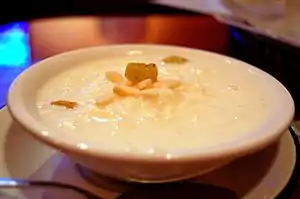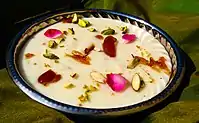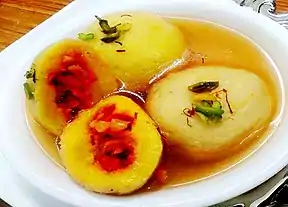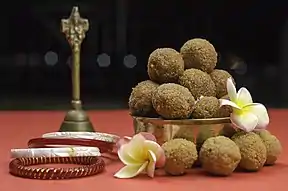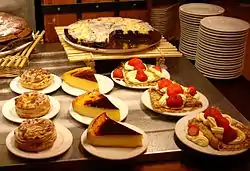Dessert
Dessert (/dɪˈzɜːrt/) is a course that concludes a meal. The course usually consists of sweet foods, such as confections, and possibly a beverage such as dessert wine or liqueur. In some parts of the world, such as much of central and western Africa, and most parts of China and India, there is no tradition of a dessert course to conclude a meal.
 Various desserts | |
| Type | Usually sweet |
|---|---|
| Variations | Numerous (biscuits, cakes, tarts, cookies, sandeshs, gelatins, ice creams, pastries, pies, puddings, custards, sweet soups, etc.) |
The term dessert can apply to many confections, such as biscuits, cakes, cookies, custards, gelatins, ice creams, pastries, pies, puddings, sweet soups, and tarts. Fruit is also commonly found in dessert courses because of its naturally occurring sweetness. Some cultures sweeten foods that are more commonly savory to create desserts.
Etymology
The word "dessert" originated from the French word desservir, meaning "to clear the table."[1] Its first known use was in 1600, in a health education manual entitled Naturall and artificial Directions for Health, written by William Vaughan.[2][3] In his A History of Dessert (2013), Michael Krondl explains that it refers to the fact that dessert was served after the table had been cleared of other dishes.[4] The term dates from the 14th century but attained its current meaning around the beginning of the 20th century, when "service à la française" (setting a variety of dishes on the table at the same time) was replaced with "service à la russe" (presenting a meal in courses).[4]
Other names
The word "dessert" is most commonly used for this course in Australia, Canada, Ireland, New Zealand, and the United States, while it is one of several synonyms (including "pudding", "sweet" and "afters") in the United Kingdom and some other Commonwealth countries.[5]
History
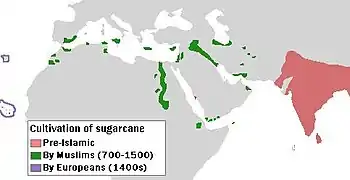

Sweets were fed to the gods in ancient Mesopotamia[7]:6 and ancient India[7]:16 and other ancient civilizations.[8] Dried fruit and honey were probably the first sweeteners used in most of the world, but the spread of sugarcane around the world was essential to the development of dessert.[7]:13
Sugarcane was grown and refined in India before 500 BC[7]:26 and was crystallized, making it easy to transport, by AD 500. Sugar and sugarcane were traded, making sugar available to Macedonia by 300 BC and China by AD 600. In the Indian subcontinent, the Middle East, and China, sugar has been a staple of cooking and desserts for over a thousand years. Sugarcane and sugar were little known and rare in Europe until the twelfth century or later when the Crusades and then colonization spread its use.
Herodotus mentions that, as opposed to the Greeks, the main Persian meal was simple, but they would eat many desserts afterwards.[9][10]
Europeans began to manufacture sugar in the Middle Ages, and more sweet desserts became available.[11] Even then sugar was so expensive usually only the wealthy could indulge on special occasions. The first apple pie recipe was published in 1381.[12] The earliest documentation of the term cupcake was in "Seventy-five Receipts for Pastry, Cakes, and Sweetmeats" in 1828 in Eliza Leslie's Receipts cookbook.[13]
The Industrial Revolution in Europe and later America caused desserts (and food in general) to be mass-produced, processed, preserved, canned, and packaged. Frozen foods, including desserts, became very popular starting in the 1920s when freezing emerged. These processed foods became a large part of diets in many industrialized nations. Many countries have desserts and foods distinctive to their nations or region.[14]
Ingredients
Sweet desserts usually contain cane sugar, palm sugar, brown sugar, honey, or some types of syrup such as molasses, maple syrup, treacle, or corn syrup. Other common ingredients in Western-style desserts are flour or other starches, Cooking fats such as butter or lard, dairy, eggs, salt, acidic ingredients such as lemon juice, and spices and other flavoring agents such as chocolate, peanut butter, fruits, and nuts. The proportions of these ingredients, along with the preparation methods, play a major part in the consistency, texture, and flavor of the end product.
Sugars contribute moisture and tenderness to baked goods. Flour or starch components serves as a protein and gives the dessert structure. Fats contribute moisture and can enable the development of flaky layers in pastries and pie crusts. The dairy products in baked goods keep the desserts moist. Many desserts also contain eggs, in order to form custard or to aid in the rising and thickening of a cake-like substance. Egg yolks specifically contribute to the richness of desserts. Egg whites can act as a leavening agent[15] or provide structure. Further innovation in the healthy eating movement has led to more information being available about vegan and gluten-free substitutes for the standard ingredients, as well as replacements for refined sugar.
Desserts can contain many spices and extracts to add a variety of flavors. Salt and acids are added to desserts to balance sweet flavors and create a contrast in flavors. Some desserts are coffee-flavored, for example an iced coffee soufflé or coffee biscuits.[16] Alcohol can also be used as an ingredient, to make alcoholic desserts.[17]
Varieties & elements
Dessert consist of variations of tasted, textures, and appearances. Desserts can be defined as a usually sweeter course that concludes a meal.[1] This definition includes a range of courses ranging from fruits or dried nuts to multi-ingredient cakes and pies. Many cultures have different variations of dessert. In modern times the variations of desserts have usually been passed down or come from geographical regions. This is one cause for the variation of desserts. These are some major categories in which desserts can be placed.[4]
Cakes
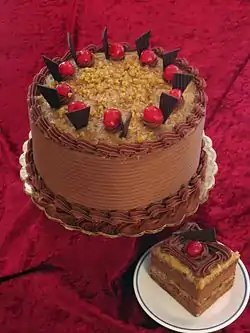
Cakes are sweet tender breads made with sugar and delicate flour. Cakes can vary from light, airy sponge cakes to dense cakes with less flour. Common flavorings include dried, candied or fresh fruit, nuts, cocoa or extracts. They may be filled with fruit preserves or dessert sauces (like pastry cream), iced with buttercream or other icings, and decorated with marzipan, piped borders, or candied fruit. Cake is often served as a celebratory dish on ceremonial occasions, for example weddings, anniversaries, and birthdays. Small-sized cakes have become popular, in the form of cupcakes and petits fours.
Puddings
Puddings are thickened with starches such as corn starch or tapioca.[18]
Small cakes & pastries
A batched dough between a cake and pastry by the mix of ingredients. An Old French bescuit, commonly spelt in English as biscuit, is a derivation of Latin for twice-baked.[19][n 1] A Dutch koekje, commonly spelt in English as cookie, is a derivation of cake-ie , meaning little cake.
This form of dough can have a texture that is crisp, hard, chewy, or soft – in the UK a biscuit is the former two and a cookie is typically the latter. Examples include a ginger nut, shortbread biscuit and chocolate chip cookie.
Other small cakes and pastries can also be counted as under these terms, due to their size and relative similarity to cookies and biscuits, such as jaffa cakes and Eccles cakes.
Confection

Confection, also called candy, sweets or lollies, features sugar or honey as a principal ingredient.
Many involve sugar heated into crystals with subtle differences. Dairy and sugar based include caramel, fudge and toffee or taffy. They are multiple forms of egg and sugar meringues. and similar confections. Unheated sugar co-adulate into icings, preservatives and sauces with other ingredients.
Chocolate
Theobroma cacao beans can be a substitute or more commonly mixed with sugar to form chocolate is Pure, unsweetened dark chocolate contains primarily cocoa solids. Cocoa butter is also added in varying proportions. Much of the chocolate currently consumed is in the form of sweet chocolate, combining chocolate with sugar. Milk chocolate is sweet chocolate that additionally contains milk powder or condensed milk. White chocolate contains cocoa butter, sugar, and milk, but no cocoa solids. Dark chocolate is produced by adding fat and sugar to the cacao mixture, with no milk or much less than milk chocolate.
Custards
These kinds of desserts usually include a thickened dairy base. Custards are cooked and thickened with eggs. Baked custards include crème brûlée and flan. They are often used as ingredients in other desserts, for instance as a filling for pastries or pies.
Deep-fried
_bright.jpg.webp)
Many cuisines include a dessert made of deep-fried starch-based batter or dough. In many countries, a doughnut is a flour-based batter that has been deep-fried. It is sometimes filled with custard or jelly. Fritters are fruit pieces in a thick batter that have been deep fried. Gulab jamun is an Indian dessert made of milk solids kneaded into a dough, deep-fried, and soaked in honey. Churros are a deep-fried and sugared dough that is eaten as dessert or a snack in many countries. Doughnuts are most famous for being a trademark favorite of fictional character Homer Simpson from the animated television series The Simpsons.[20]
Frozen
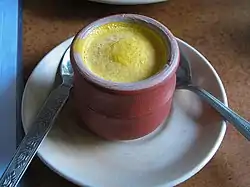
Ice cream, gelato, sorbet and shaved-ice desserts fit into this category. Ice cream is a cream base that is churned as it is frozen to create a creamy consistency. Gelato uses a milk base and has less air whipped in than ice cream, making it denser. Sorbet is made from churned fruit and is not dairy based. Shaved-ice desserts are made by shaving a block of ice and adding flavored syrup or juice to the ice shavings.
Gelatin
Jellied desserts are made with a sweetened liquid thickened with gelatin or another thickening agent. They are traditional in many cultures. Grass jelly and annin tofu are Chinese jellied desserts. Yōkan is a Japanese jellied dessert. In English-speaking countries, many dessert recipes are based on gelatin with fruit or whipped cream added. The vegetarian substitute for Gelatin is Agar. Marshmallow is also most commonly made with gelatin.
Pastries
.jpg.webp)
Pastries are sweet baked pastry products. Pastries can either take the form of light and flaky bread with an airy texture, such as a croissant or unleavened dough with a high fat content and crispy texture, such as shortbread. Pastries are often flavored or filled with fruits, chocolate, nuts, and spices. Pastries are sometimes eaten with tea or coffee as a breakfast food.
Pies, cobblers, and clafoutis
Pies and cobblers are a crust with a filling. The crust can be either made from either a pastry or crumbs. Pie fillings range from fruits to puddings; cobbler fillings are generally fruit-based. Clafoutis are a batter with fruit-based filling poured over the top before baking.
Sweet soups
Tong sui, literally translated as "sugar water" and also known as tim tong, is a collective term for any sweet, warm soup or custard served as a dessert at the end of a meal in Cantonese cuisine. Tong sui are a Cantonese specialty and are rarely found in other regional cuisines of China. Outside of Cantonese-speaking communities, soupy desserts generally are not recognized as a distinct category, and the term tong sui is not used.
Wines
Dessert wines are sweet wines typically served with dessert. There is no simple definition of a dessert wine. In the UK, a dessert wine is considered to be any sweet wine drunk with a meal, as opposed to the white[21] fortified wines (fino and amontillado sherry) drunk before the meal, and the red fortified wines (port and madeira) drunk after it. Thus, most fortified wines are regarded as distinct from dessert wines, but some of the less strong fortified white wines, such as Pedro Ximénez sherry and Muscat de Beaumes-de-Venise, are regarded as honorary dessert wines. In the United States, by contrast, a dessert wine is legally defined as any wine over 14% alcohol by volume, which includes all fortified wines - and is taxed at higher rates as a result. Examples include Sauternes and Tokaji Aszú.
Gallery
- Dessert examples
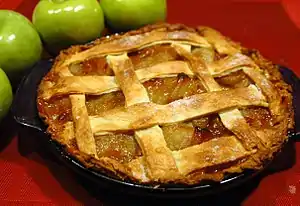
.jpg.webp) Baked Alaska, ice cream and cake topped with browned meringue
Baked Alaska, ice cream and cake topped with browned meringue Baklava, a pastry comprising layers of filo with chopped nuts, sweetened and held together with syrup or honey
Baklava, a pastry comprising layers of filo with chopped nuts, sweetened and held together with syrup or honey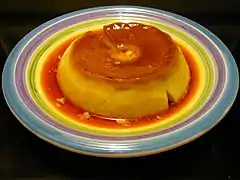 Baked custard
Baked custard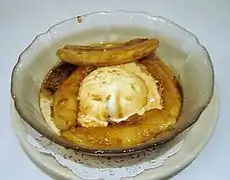 Bananas Foster, made from bananas and vanilla ice cream with a sauce made from butter, brown sugar, cinnamon, dark rum and banana liqueur
Bananas Foster, made from bananas and vanilla ice cream with a sauce made from butter, brown sugar, cinnamon, dark rum and banana liqueur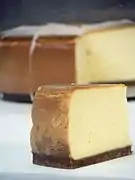 Cheesecake, a type of dessert with a layer of a mixture of soft, fresh cheese, eggs and sugar
Cheesecake, a type of dessert with a layer of a mixture of soft, fresh cheese, eggs and sugar.jpg.webp) Cannolis with Pistachio Grain, Candied and Chocolate Drops
Cannolis with Pistachio Grain, Candied and Chocolate Drops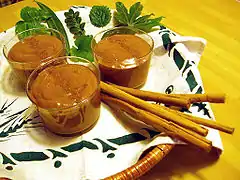 Chocolate mousse, a chocolate variety of a dessert incorporating air bubbles to give it a light and airy texture
Chocolate mousse, a chocolate variety of a dessert incorporating air bubbles to give it a light and airy texture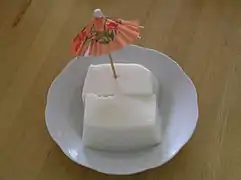 Coconut bar, made with coconut milk and set with either tang flour and corn starch, or agar agar and gelatin
Coconut bar, made with coconut milk and set with either tang flour and corn starch, or agar agar and gelatin Preparation of crème brûlée, a rich custard base topped with a contrasting layer of hard caramel
Preparation of crème brûlée, a rich custard base topped with a contrasting layer of hard caramel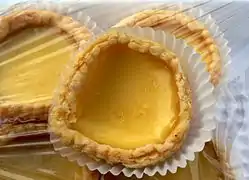 Egg custard tarts, a pastry originating from Guangzhou, China.
Egg custard tarts, a pastry originating from Guangzhou, China..JPG.webp) Gyeongju bread, a small pastry with a filling of red bean paste
Gyeongju bread, a small pastry with a filling of red bean paste Hotteok (a variety of filled Korean pancake) with edible seeds, sugar, and cinnamon
Hotteok (a variety of filled Korean pancake) with edible seeds, sugar, and cinnamon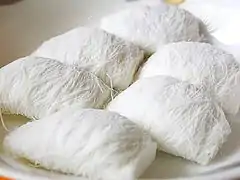
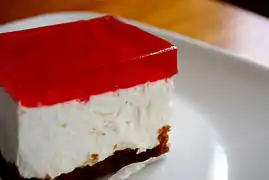 Jell-o cream cheese square
Jell-o cream cheese square.jpg.webp) Lemon tart, a pastry shell with a lemon-flavored filling
Lemon tart, a pastry shell with a lemon-flavored filling
 An assortment of pastries
An assortment of pastries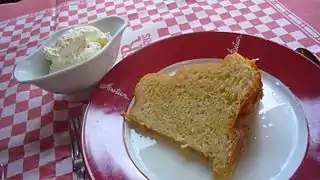 Rum cake, a type of cake containing rum
Rum cake, a type of cake containing rum
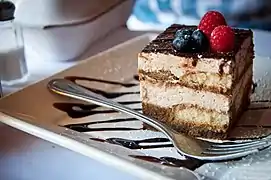
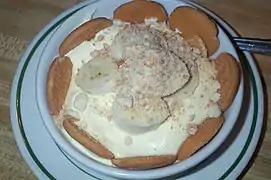 Homemade banana pudding
Homemade banana pudding
By continent
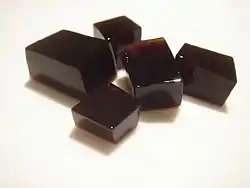
Africa
Throughout much of central and western Africa, there is no tradition of a dessert course following a meal.[22][23] Fruit or fruit salad would be eaten instead, which may be spiced, or sweetened with a sauce. In some former colonies in the region, the colonial power has influenced desserts – for example, the Angolan cocada amarela (yellow coconut) resembles baked desserts in Portugal.[23]
Asia
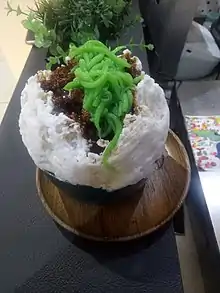
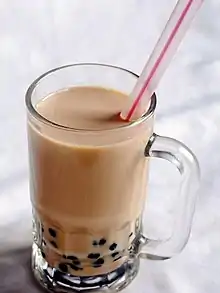
In Asia, desserts are often eaten between meals as snacks rather than as a concluding course. There is widespread use of rice flour in East Asian desserts, which often include local ingredients such as coconut milk, palm sugar, and tropical fruit.[24] In India, where sugarcane has been grown and refined since before 500 BC, desserts have been an important part of the diet for thousands of years; types of desserts include burfis, halvahs, jalebis, and laddus.[7]:37
Dessert nowadays are made into drinks as well, such as Bubble Tea. It is originated in Taiwan, which locates in East Asia. Bubble tea is a kind of dessert made with flavor tea or milk with tapioca. It is well-known across the world.[25]
Recently, CNN Travel released a list of 50 of the world’s best desserts after travelling around the world and one of the items on the list is cendol. While the origins of cendol are not confirmed, there have been reports that it either came from Malaysia or Indonesia.
India
Europe

In Ukraine and Russia, breakfast foods such as nalysnyky or blintz or oladi (pancake), and syrniki are served with honey and jam as desserts.
North America
European colonization of the Americas yielded the introduction of a number of ingredients and cooking styles. The various styles continued expanding well into the 19th and 20th centuries, proportional to the influx of immigrants.
South America
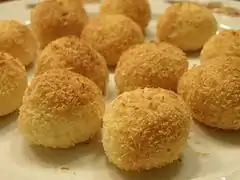
Dulce de leche is a very common confection in Argentina.[26] In Bolivia, sugarcane, honey and coconut are traditionally used in desserts.[27] Tawa tawa is a Bolivian sweet fritter prepared using sugar cane, and helado de canela is a dessert that is similar to sherbet which is prepared with cane sugar and cinnamon.[27] Coconut tarts, puddings cookies and candies are also consumed in Bolivia.[27] Brazil has a variety of candies such as brigadeiros (chocolate fudge balls), cocada (a coconut sweet), beijinhos (coconut truffles and clove) and romeu e julieta (cheese with a guava jam known as goiabada). Peanuts are used to make paçoca, rapadura and pé-de-moleque. Local common fruits are turned in juices and used to make chocolates, ice pops and ice cream.[28] In Chile, kuchen has been described as a "trademark dessert."[29] Several desserts in Chile are prepared with manjar, (caramelized milk), including alfajor, flan, cuchufli and arroz con leche.[29] Desserts consumed in Colombia include dulce de leche, waffle cookies,[30] puddings, nougat, coconut with syrup and thickened milk with sugarcane syrup.[31] Desserts in Ecuador tend to be simple, and desserts are a moderate part of the cuisine.[32] Desserts consumed in Ecuador include tres leches cake, flan, candies and various sweets.[32]
Market
The market for desserts has grown over the last few decades, which was greatly increased by the commercialism of baking desserts and the rise of food productions. Desserts are present in most restaurants as the popularity has increased. Many commercial stores have been established as solely desserts stores. Ice cream parlors have been around since before 1800.[34] Many businesses started advertising campaigns focusing solely on desserts. The tactics used to market desserts are very different depending on the audience for example desserts can be advertised with popular movie characters to target children.[35] The rise of companies like Food Network has marketed many shows which feature dessert and their creation. Shows like these have displayed extreme desserts and made a game show atmosphere which made desserts a more competitive field.[36]
Desserts are a standard staple in restaurant menus, with different degrees of variety. Pie and cheesecake were among the most popular dessert courses ordered in U.S. restaurants in 2012.[37]
Nutrition
Dessert foods often contain relatively high amounts of sugar and fats and, as a result, higher calorie counts per gram than other foods. Fresh or cooked fruit with minimal added sugar or fat is an exception.[38]
See also
- Chinese desserts
- Culinary art
- hRecipe – a microformat for marking-up recipes in web pages
References
- "Dessert". Merriam-Webster Dictionary. Merriam-Webster Incorporated. Retrieved 15 October 2012.
- "dessert". Oxford English Dictionary (Online ed.). Oxford University Press. (Subscription or participating institution membership required.)
- Charlton, Anne (2005). "An example of health education in the early 17th century: Naturall and artificial Directions for Health by William Vaughan". Health Education Research. 20 (6): 656–664. doi:10.1093/her/cyh030. PMID 15857908.
- Drzal, Dawn. "How We Got to Dessert". The New York Times. Retrieved 23 October 2012.
- "Eating and Drinking". The Septic's Companion. Retrieved 22 July 2015.
- Elizabeth Abbot (2010). Sugar: A Bittersweet History. Penguin. ISBN 978-1-590-20297-5.
- Kondl, Michael (2011). Sweet Invention: A History of Dessert. Chicago IL: Chicago Review Press. ISBN 978-1-55652-954-2.
- "Lessons From History: Fruit is a Dessert". Nourishing Gourmet. Retrieved 21 July 2015.
- electricpulp.com. "HERODOTUS iii. DEFINING THE PERSIANS – Encyclopaedia Iranica". www.iranicaonline.org. Retrieved 7 October 2017.
- "Internet History Sourcebooks". sourcebooks.fordham.edu. Retrieved 7 October 2017.
- Adamson (2004). p. 89. Missing or empty
|title=(help) - Newcomb, Tim. "Happy Pi Day! 8 Notable Pi(e)s in History". Time. Retrieved 20 July 2015.
- "Cupcake History". Crazy About Cupcakes. Archived from the original on 2 December 2014.
- Mintz, Steven. "Food in America". Digital History. Archived from the original on 12 May 2013. Retrieved 18 October 2012.
- "Baking Flour Facts". TLC. Discovery Communications, LLC. Retrieved 23 October 2012.
- Brien, Donna Lee (May 2012). "Powdered, Essence or Brewed?: Making and Cooking with Coffee in Australia in the 1950s and 1960s". M/C Journal. 15 (2). doi:10.5204/mcj.475. Archived from the original on 22 March 2015. Retrieved 25 July 2015.
- Emoff, Katherine (21 October 2014). "Alcoholic Sweet Treats Turning Dessert Into a Party". ABC News. Archived from the original on 18 March 2015. Retrieved 25 July 2015.
- Bloom, Carole (2006). The essential baker : the comprehensive guide to baking with fruits, nuts, spices, chocolate, and other ingredients. Hoboken, NJ: Wiley. p. 672. ISBN 978-0-7645-7645-4.
- "Biscuit". Oxford English Dictionary. Oxford University Press. 2009.
- "Why Homer Simpson's pink doughnut is the ring to rule them all - CNET". Retrieved 7 April 2017.
- Breton, Félicien. "The 7 major types of white wines - French Scout".
- Wilson, Ellen Gibson (1971). A West African cook book. Distributed by Lippincott, Philadelphia. M. Evans. p. 171. Retrieved 20 July 2015.
- Roufs, Timothy G.; Roufs, Kathleen Smyth (2014). Sweet Treats around the World: An Encyclopedia of Food and Culture. Santa Barbara, California: ABC-CLIO. pp. 60–61. ISBN 978-1-61069-221-2.
- Classic Asian cakes and desserts : quick and delicious favorites. Singapore: Periplus. 2003. p. 3. ISBN 0-7946-0213-4. Retrieved 20 July 2015.
- "Bubble Tea History". www.bubbleteasupply.com. Retrieved 21 September 2017.
- Roufs, T.G.; Roufs, K.S. (2014). Sweet Treats around the World: An Encyclopedia of Food and Culture. ABC-CLIO. p. 8. ISBN 978-1-61069-221-2.
- Roufs, T.G.; Roufs, K.S. (2014). Sweet Treats around the World: An Encyclopedia of Food and Culture. ABC-CLIO. p. 44. ISBN 978-1-61069-221-2.
- Freyre, Gilberto. Açúcar. Uma Sociologia do Doce, com Receitas de Bolos e Doces do Nordeste do Brasil. São Paulo, Companhia das Letras, 1997.
- Burford, T. (2005). Chile: The Bradt Travel Guide. Bradt Guides. Bradt Travel Guides. p. 87. ISBN 978-1-84162-076-3.
- Cathey, K. (2011). Colombia – Culture Smart!: The Essential Guide to Customs & Culture. Culture Smart!. Kuperard. p. 132. ISBN 978-1-85733-549-1.
- Woods, S. (2012). Bradt Colombia. Bradt Travel Guide Colombia. Bradt Travel Guides. p. 99. ISBN 978-1-84162-364-1.
- Greenspan, E. (2011). Frommer's Ecuador and the Galapagos Islands. Frommer's Complete Guides. Wiley. p. 31. ISBN 978-1-118-10032-5.
- Burckhardt, A.L.; Germaine, E. (2004). Cooking the Australian Way. Easy Menu Ethnic Cookbooks 2nd Edition. Ebsco Publishing. p. 53. ISBN 978-0-8225-1697-2.
- Bellis, Mary. "History of Ice Cream". About.com Inventors. Retrieved 23 October 2012.
- Story, Mary (February 2004). "Food Advertising and Marketing Directed at Children and Adolescents in the US". International Journal of Behavioral Nutrition and Physical Activity. 1 (1): 3. doi:10.1186/1479-5868-1-3. PMC 416565. PMID 15171786.
- "About Food Network". Food Network.com. Food Network. Retrieved 23 October 2012.
- Top desserts ordered in restaurants 2012. Technomic, Inc. September 2012. Retrieved 3 December 2013.
- Goff, Corinne. "5 Easy To Make, Good for You Desserts". FitDay. Retrieved 23 October 2012.
Notes
- See, for example, Shakespeare's use of "Twice-sod simplicity! Bis coctus!" in Love's Labour's Lost. (David Crystal; Ben Crystal (eds.). "Love's Labour's Lost". Shakespeare's Words. Penguin Books. Archived from the original on 15 March 2017. Retrieved 15 April 2016.)
Further reading
| Wikibooks Cookbook has a recipe/module on |
- Dodge, Abigail J.; et al. (2002). Dessert. Simon & Schuster Source. ISBN 0-7432-2643-7.
- Mesnier, Roland (2004). Dessert University. Simon & Schuster. ISBN 0-7432-2317-9.
